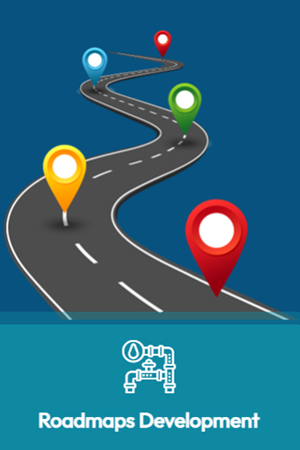
Roadmap Development
An Agile Roadmap is a high-level, visual representation of the plan for implementing an Agile methodology within an organization. It typically includes a timeline of key milestones and deliverables, and outlines the overall strategy and approach for adopting Agile.
Our Agile Roadmaps are generally less detailed and specific than a traditional waterfall project plans; emphasizing flexibility and adaptability. It
is intended to provide a general sense of direction and priorities, rather than a detailed plan that is set in stone. It usually communicates the overall direction and progress of the Agile implementation to stakeholders and provide a way to track progress.
Our Roadmaps typically includes key milestones such as training, adoption of Agile practices, and key deliverable. It also includes key metrics that will be used to measure the success of the Agile implementation. The Agile Roadmap a living document that is continuously updated and adapted as the implementation progresses.
It is also important to note that Agile Roadmap is not only used for software development projects but also for any type of projects or initiatives that are looking to adopt Agile.
Our Agile Roadmaps are generally less detailed and specific than a traditional waterfall project plans; emphasizing flexibility and adaptability. It
is intended to provide a general sense of direction and priorities, rather than a detailed plan that is set in stone. It usually communicates the overall direction and progress of the Agile implementation to stakeholders and provide a way to track progress.
Our Roadmaps typically includes key milestones such as training, adoption of Agile practices, and key deliverable. It also includes key metrics that will be used to measure the success of the Agile implementation. The Agile Roadmap a living document that is continuously updated and adapted as the implementation progresses.
It is also important to note that Agile Roadmap is not only used for software development projects but also for any type of projects or initiatives that are looking to adopt Agile.

Agile Roadmap Engagement Request
The process for developing an Agile implementation roadmap typically includes the following steps:
- Assess the current state: This involves identifying the organization's current processes, tools, and culture and determining how they align with Agile principles.
- Define the target state: This involves defining the desired outcomes of the Agile implementation, including the specific Agile methodology (e.g., Scrum, Kanban, etc.).
- Develop a plan: This involves creating a detailed plan for implementing Agile, including timelines, resources, and roles and responsibilities.
- Communicate and train: This involves communicating the plan to all stakeholders and providing training to ensure that everyone understands the Agile methodology and their role in the implementation.
- Implement and monitor: This involves implementing the plan and monitoring progress to ensure that the Agile implementation is on track.
- Continuously improve: This involves regularly reviewing and assessing the Agile implementation and making adjustments as necessary to ensure that it remains effective.
It's also important to note that Agile is a mindset, not just a set of practices. Thus, Agile adoption should be done holistically and not just a set of practices. It's also important to involve key stakeholders and ensure everyone is on board before implementing a program.



Agility Engineers
11877 Douglas Road
Suite 102, #328A
Alpharetta, GA 30005
(404) 476-7800
11877 Douglas Road
Suite 102, #328A
Alpharetta, GA 30005
(404) 476-7800
Services
Agile Assessments
Roadmap Development
Best Practices
Staff Augmentation
Roadmap Development
Best Practices
Staff Augmentation
Quick Links
Events
Contacts
Investor Relations
Contacts
Investor Relations
Join Our Community!
Are You an Agile or Transformation Thought Leaders?
Join Our Community Of Agility Engineers, Practitioners & Leaders! Together We Can Help Drive Global Agility.
Join Our Community Of Agility Engineers, Practitioners & Leaders! Together We Can Help Drive Global Agility.
